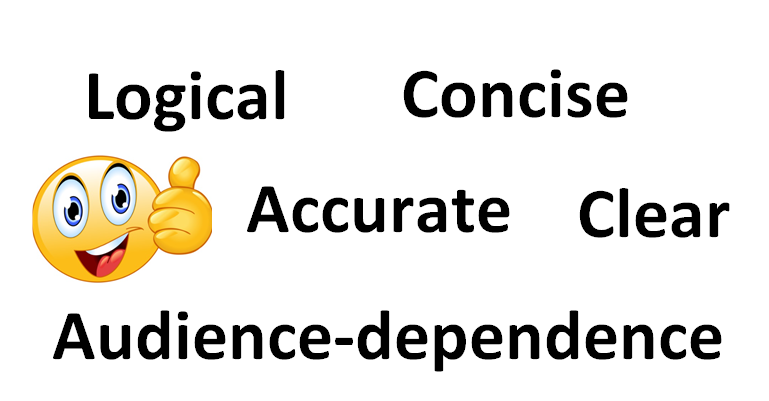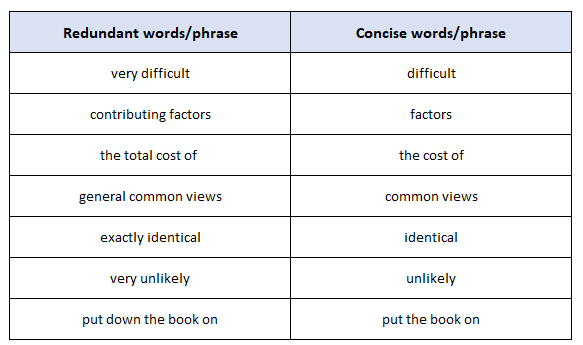Five fundamental rules for scientific writing that are applicable for all fields
This post explains five important rules to write scientific articles. The rules can be applied to all types of research fields. The five rules are logical, clear, accurate, concise and audience-dependence.

This post explains five important rules for writing scientific articles. The rules can be applied to all types of research fields.
Regardless of what types of fields (engineering, science, medicine to social science) people work in, there are general rules, to follow, for scientific articles.
The five rules are logical, clear, accurate, concise and audience-dependence.
Next, we will discuss each of the five rules.
Logical
Being logical is the main thing for scientific arguments to have. Being logical means that a claim or argument is based on, at least, one or more other valid claims or arguments.
In general, a final claim is called “conclusion” and other claims that support the final claim are known as “premises”. The premises should be true, otherwise, the conclusion supported by the premises will be not valid or incorrect.
A simple formula to test whether an argument or arguments is logical or not is by using this formula:

From the formula above, a simple way to test our arguments can be applied. Examples of arguments, both logical and not logical, are presented as follows.
Example of non-valid arguments
X = “the baking temperature of breads is very high”
Y = “the bread tastes are not good”
If X then Y: “If the baking temperature of breads is very high, then the bread tastes are not good”
Y therefore X: “The bread tastes are not good. Therefore, the baking temperature of breads is very high”
In this example, in the format of “If X then Y”, the arguments are still valid. Because, when we bake breads at very high temperatures (with respect to an appropriate temperature to bake breads), most likely the breads will be overcooked. These overcooked breads will negatively affect the taste and texture of the breads.
However, in the format of “Y therefore X”, when the tastes of the breads are not good or not as desired, the reasons of the bad tastes can be vary and are not necessarily due to the breads are baked at very high temperatures until overcooked. The reasons can be, for example, due to incorrect ingredients or incorrect water compositions.
The two arguments above do not comply with both formats “if Xthen Y” and “Y therefore X”. This non-compliance to both formats shows that the logic of the arguments is not valid.
The use of both forms can be a handy tool to check the validity of arguments regardless of what field of science the arguments are presented.
In scientific writing, all arguments or statements should be valid so that the arguments can be accepted as knowledge.
Example of valid arguments
X = “the baking temperature of breads is very high”
Y = “the bread surfaces become blackish”
If X then Y: “If the baking temperature of breads is very high, then the bread surfaces become blackish”
Y therefore X: “The bread surfaces become blackish. Therefore, the baking temperature of breads is very high”
In this example, the two arguments are still valid in both formats “if X then Y” and “Y therefore X”. If the baking temperature is very high, then, most likely, the surface of the breads will become blackish due to overcook.
And otherwise, the bread surfaces are blackish. Therefore, most likely the breads are baked at very high temperatures and get overcooked.
So, since the arguments in this example comply with the two formats. We can say that the arguments are valid.
Note that there is a takeaway from the two examples above. The takeaway is that when making scientific arguments, we need to make the arguments specific to minimise or eliminate multiple interpretations by readers.
Another way to strengthen arguments is to also give valid and relevant references that support the arguments, for example, journal articles, conference papers, theses and/or technical reports. This cross-referencing is one of the essentials in scientific writing to justify arguments and link knowledge.
Clear
Any research findings should be written and published so that the findings can be used for others and become useful. Hence, those findings need to be written in simple, but clear, English. That is, the writing should be clear, direct and non-ambiguous.
Readers can read this post for more examples of ambiguous sentences and how to avoid them.
To be clear, we need to avoid using extravagance and long words in writing scientific arguments or findings. If these words are used, the sentence will become difficult to understand and follow.
Clear sentences with simple English and words will be more appreciated by other people.
Ambiguity is the biggest enemy in scientific writing.
Example of unclear sentences
“From perfect experiments with large numbers of repetitions of which every single repetition requires 30 minutes of running time, high cooling speed set on the chamber that has extremely high temperature set to 1000 degrees Celsius increases the hardness of the surface at a certain thickness of alloyed-steel materials.”
From the example above, the whole sentences are too long and difficult to understand. There are at least two extravaganza words, that are “perfect” and “extremely high”.
There are no perfect experiments and the temperature discussed above is not extreme as it is common in alloyed-steel processing. The main information of the sentences is buried under other unnecessary sentences.
The sentences in this example will not be appreciated by readers, especially reviewers who will read and judge the quality of the article containing the sentences.
Example of a clear sentence
“From experiments, high cooling speed increases the hardness of alloyed-steel materials.”
In this example, the sentences are short, but concise. All words are meaningful and there are no extravagance words or any other unnecessary information.
This type of sentences is much more appreciated by readers than the longer sentences in the previous example.

Accurate
One of the essences of scientific publications is that other researchers can understand new findings and can repeat the experiments (or methods or programs) reported in the publications when necessary.
We need to use accurate words so that readers can understand exactly our results (in a quantitative sense) and can relate our results to other results. In another way, we need to convey information in exact meaning with one interpretation only.
Example of an inaccurate sentence
“By using the new algorithm, a large reduction in processing time can be obtained compared to the previous algorithm.”
In this example, the word “large” is not accurate because it is difficult to measure how much time reduction is gained. We cannot quantitatively compare the processing time of the new algorithm with the previous algorithm.
Example of an accurate sentence
“By using the new algorithm, a five times reduction in processing time can be obtained compared to the previous algorithm.”
In this example, instead of using “large”, we say “five times” (with a number). Since we say five times, we can quantitively compare the processing time between the new algorithm and the old algorithm.
That is, if the old algorithm requires 20 minutes of processing time, then the new algorithm only requires four minutes of processing time.
Concise
In Scientific writing, sentences should be concisely written. Not only the sentences will be clear but also will save spaces.
Most journals nowadays limit the number of pages in scientific articles. This limitation forces us to be able to write concisely. Of course, the main reason should be still for the clarity of the sentences.
The main rule to write concisely is by avoiding redundant words/phrases, for example (just to mention a few) below:

Audience-dependence
Last but not least, we need to know and understand who the readers will be for our articles. Every reader, journal and research field has their own specific common terms and ways of writing. Although, general rules of writing are still applied.
For example, in dimensional and geometrical measurement fields, errors are commonly interpreted as errors in length and have units in metre, millimetre or nanometre. Meanwhile, in signal processing fields, errors are commonly presented in dB (decibels).
By knowing these common terms or contexts, we can present our data correctly and can be easily understood by the readers in their specific fields.
Also, we need to adjust our writing depending on where the writing will be published: either in a scientific journal, scientific magazine, non-scientific magazine or blog. The style of writing a journal article is very different from the style of writing a blog post.
Of course, although the arguments are valid, we cannot use the writing style for a blog when we are writing an article for a scientific journal.
Conclusion
In this post, five basic important rules for writing scientific articles are explained. The five rules are: logical, clear, accurate, concise and audience-dependence.
A handy tool to check the logic of arguments is presented and explained.
These basic rules are very fundamental for those who write scientific articles. By following these rules, a clear article can be obtained that is easy to understand, follow, interpret results and reproduce results presented in the article.
Writing scientific articles is vital for researchers to convey their new findings and contribute to the knowledge in their field.
We sell all the source files, EXE file, include and LIB files as well as documentation of ellipse fitting by using C/C++, Qt framework, Eigen and OpenCV libraries in this link.
We sell tutorials (containing PDF files, MATLAB scripts and CAD files) about 3D tolerance stack-up analysis based on statistical method (Monte-Carlo/MC Simulation).